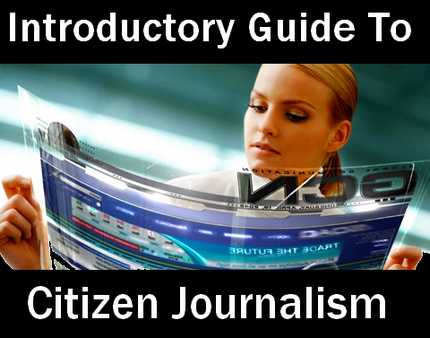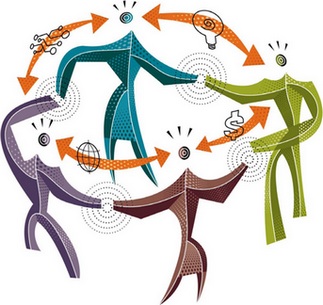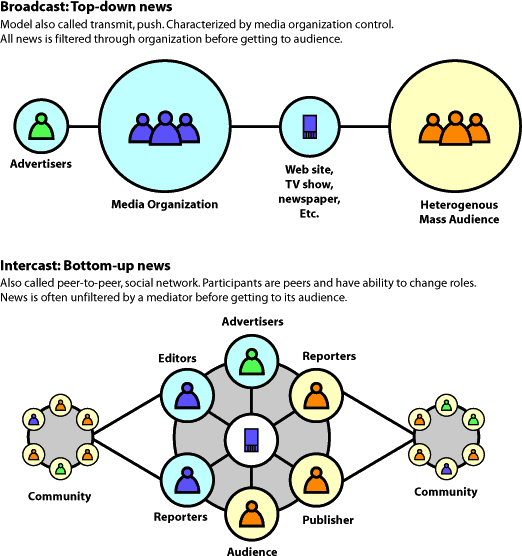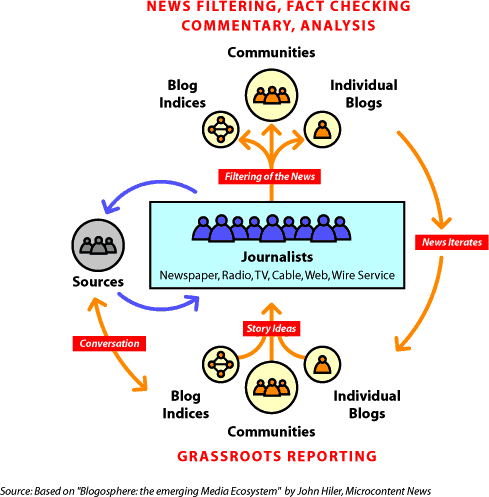 Photo credit: Paulino Figueirido
Unfortunately, popular belief has it that news coming from official, mainstream channels is superior in quality and reliability than news reported by a blogger or someone with a shaky camcorder. Traditional media keep being preached as the source of truth, but what they lack is exactly the essence of truth: validation.
How do you establish what is true form what is false? Mainstream media have a one-way dialogue with their audience: there's no way to check back what was told or written. Participatory journalism, on the contrary, finds its very strength in the continuous, ongoing validation process operated by a large community. You can easily share your opinion, agree / disagree with what is being said by taking advantage of new technologies and the web. This is why it is also called Participatory Journalism.
Participatory Journalism is:
Photo credit: Paulino Figueirido
Unfortunately, popular belief has it that news coming from official, mainstream channels is superior in quality and reliability than news reported by a blogger or someone with a shaky camcorder. Traditional media keep being preached as the source of truth, but what they lack is exactly the essence of truth: validation.
How do you establish what is true form what is false? Mainstream media have a one-way dialogue with their audience: there's no way to check back what was told or written. Participatory journalism, on the contrary, finds its very strength in the continuous, ongoing validation process operated by a large community. You can easily share your opinion, agree / disagree with what is being said by taking advantage of new technologies and the web. This is why it is also called Participatory Journalism.
Participatory Journalism is: The act of a citizen, or group of citizens, playing an active role in the process of collecting, reporting, analyzing and disseminating news and information. The intent of this participation is to provide independent, reliable, accurate, wide-ranging and relevant information that a democracy requires.If you want to understand better the spirit behind citizen journalism, and why it might be a long step forward in the way you both produce and consume information online, this classic report is a must read. Here all the details:
We Media: Introduction To Participatory Journalism
 by Chris Willis and Shayne Bowman
by Chris Willis and Shayne Bowman
In his 1995 book Being Digital, Nicholas Negroponte predicted that in the future, online news would give readers the ability to choose only the topics and sources that interested them. "The Daily Me," as Negroponte called it, worried many guardians of traditional journalism. To actively allow a reader to narrow the scope of coverage, observed some, could undermine the "philosophical underpinnings of traditional media." The vision that seemed cutting edge and worrisome eight years ago seems to have come partly true. The Wall Street Journal, MSNBC.com, The Washington Post and CNN, to name a few, all offer readers some degree of personalization on the front pages of their sites. Millions of Yahoo members customize their MyYahoo personal news portal with the same news wire reports that editors use in daily newspapers across the globe. Google's news page uses a computer algorithm to select headlines from thousands of news sites - creating a global newsstand, of sorts. And media outlets from Fox News and the Drudge Report to individual weblogs offer the kind of opinionated slant to the news that Negroponte envisioned. But is the future of online news simply a continued extrapolation of this trend - news a la carte? Does greater personalization necessarily mean greater understanding for a democracy? In the view of futurist and author Watts Wacker, the question is not about greater personalization but about greater perspectives. According to Wacker, the world is moving faster than people can keep up with it. As a result, there are fewer common cultural references that can be agreed upon. Ideas, styles, products and mores accelerate their way from the fringe to the mainstream with increasing speed. To combat the confusion, consumers are seeking more perspectives, Wacker says. They research an automobile for purchase by spending time online and reading both professional and amateur reviews alike. But what are they doing when it comes to news? And what will they be doing in the future? To understand that, Wacker advises, you must seek out people from the future today and study them. How do you find people from the future? Locate early adopters - people who are using and appropriating technology in new ways. In South Korea, it looks like one future of online news has arrived a few years early. OhmyNews.com is the most influential online news site in that country, attracting an estimated 2 million readers a day. What's unusual about OhmyNews.com is that readers not only can pick and choose the news they want to read - they also write it. With the help of more than 26,000 registered citizen journalists, this collaborative online newspaper has emerged as a direct challenge to established media outlets in just four years. Unlike its competitors, OhmyNews has embraced the speed, responsiveness and community-oriented nature of the Web. Now, it appears, the vision of "The Daily Me" is being replaced by the idea of "The Daily We."
Behind The Citizen Journalism Revolution
Chriss Hogg and and David Silverberg of DigitalJournal.com analyze the citizen journalism phenomenon and its most famous examples. Duration: 7' 23''The Rise of We Media
 The venerable profession of journalism finds itself at a rare moment in history where, for the first time, its hegemony as gatekeeper of the news is threatened by not just new technology and competitors but, potentially, by the audience it serves.
Armed with easy-to-use web publishing tools, always-on connections and increasingly powerful mobile devices, the online audience has the means to become an active participant in the creation and dissemination of news and information. And it's doing just that on the Internet:
The venerable profession of journalism finds itself at a rare moment in history where, for the first time, its hegemony as gatekeeper of the news is threatened by not just new technology and competitors but, potentially, by the audience it serves.
Armed with easy-to-use web publishing tools, always-on connections and increasingly powerful mobile devices, the online audience has the means to become an active participant in the creation and dissemination of news and information. And it's doing just that on the Internet:
- According to the Pew Internet Project, the terrorist attacks of Sept. 11, 2001, generated the most traffic to traditional news sites in the history of the Web. Many large news sites buckled under the immense demand and people turned to e-mail, weblogs and forums "as conduits for information, commentary, and action related to 9/11 events." The response on the Internet gave rise to a new proliferation of "do-it-yourself journalism." Everything from eyewitness accounts and photo galleries to commentary and personal storytelling emerged to help people collectively grasp the confusion, anger and loss felt in the wake of the tragedy.
- During the first few days of the war in Iraq, Pew found that 17 percent of online Americans used the Internet as their principal source of information about the war, a level more than five times greater than those who got their news online immediately after the Sept. 11 terrorist attacks (3 percent). The report also noted that "weblogs (were) gaining a following among a small number of Internet users (4 percent)."
- Immediately after the Columbia shuttle disaster, news and government organizations, in particular The Dallas Morning News and NASA, called upon the public to submit eyewitness accounts and photographs that might lead to clues to the cause of the spacecraft's disintegration.
- ABCNews.com's The Note covers 2004 political candidates and gives each an individual weblog to comment back on what was reported. In addition, presidential candidate Howard Dean guest-blogged on Larry Lessig's weblog for a week in July 2003. (A future president of the United States might be chosen not only on his or her merits, charisma, experience or voting record but on the basis of how well he or she blogs.)
- College coaches, players and sports media outlets keep constant vigil on numerous fan forum sites, which have been credited with everything from breaking and making news to rumor-mongering. "You can't go anywhere or do anything and expect not to be seen, because everyone is a reporter now," says Steve Patterson, who operates ugasports.com, a web site devoted to University of Georgia sports.
- Before the Iraq war, the BBC knew it couldn't possibly deploy enough photojournalists to cover the millions of people worldwide who marched in anti-war demonstrations. Reaching out to its audience, the BBC News asked readers to send in images taken with digital cameras and cell phones with built-in cameras, and it published the best ones on its web site.
Citizen Journalism - What Is It
Robin Good has edited a short video published by Cambridge Community Television explaining what citizen journalism really is about - Full video here Duration: 9' 49''Weblogs Come of Age
 The Internet, as a medium for news, is maturing. With every major news event, online media evolve. And while news sites have become more responsive and better able to handle the growing demands of readers and viewers, online communities and personal news and information sites are participating in an increasingly diverse and important role that, until recently, has operated without significant notice from mainstream media.
While there are many ways that the audience is now participating in the journalistic process, which we will address in this report, weblogs have received the most attention from mainstream media in the past year.
Weblogs, or blogs as they are commonly known, are the most active and surprising form of this participation. These personal publishing systems have given rise to a phenomenon that shows the markings of a revolution - giving anyone with the right talent and energy the ability to be heard far and wide on the Web.
Weblogs are frequently updated online journals, with reverse-chronological entries and numerous links, that provide up-to-the-minute takes on the writer's life, the news, or on a specific subject of interest. Often riddled with opinionated commentary, they can be personally revealing (such as a college student's ruminations on dorm life) or straightforward and fairly objective (Romenesko).
The growth of weblogs has been largely fueled by greater access to bandwidth and low-cost, often free software. These simple easy-to-use tools have enabled new kinds of collaboration unrestricted by time or geography. The result is an advance of new social patterns and means for self-expression.
Blog-like communities like Slashdot.org have allowed a multitude of voices to participate while managing a social order and providing a useful filter on discussion.
Weblogs have expanded their influence by attracting larger circles of readers while at the same time appealing to more targeted audiences.
The Internet, as a medium for news, is maturing. With every major news event, online media evolve. And while news sites have become more responsive and better able to handle the growing demands of readers and viewers, online communities and personal news and information sites are participating in an increasingly diverse and important role that, until recently, has operated without significant notice from mainstream media.
While there are many ways that the audience is now participating in the journalistic process, which we will address in this report, weblogs have received the most attention from mainstream media in the past year.
Weblogs, or blogs as they are commonly known, are the most active and surprising form of this participation. These personal publishing systems have given rise to a phenomenon that shows the markings of a revolution - giving anyone with the right talent and energy the ability to be heard far and wide on the Web.
Weblogs are frequently updated online journals, with reverse-chronological entries and numerous links, that provide up-to-the-minute takes on the writer's life, the news, or on a specific subject of interest. Often riddled with opinionated commentary, they can be personally revealing (such as a college student's ruminations on dorm life) or straightforward and fairly objective (Romenesko).
The growth of weblogs has been largely fueled by greater access to bandwidth and low-cost, often free software. These simple easy-to-use tools have enabled new kinds of collaboration unrestricted by time or geography. The result is an advance of new social patterns and means for self-expression.
Blog-like communities like Slashdot.org have allowed a multitude of voices to participate while managing a social order and providing a useful filter on discussion.
Weblogs have expanded their influence by attracting larger circles of readers while at the same time appealing to more targeted audiences. "Blogs are in some ways a new form of journalism, open to anyone who can establish and maintain a Web site, and they have exploded in the past year,"writes Walter Mossberg, technology columnist for the Wall Street Journal.
"The good thing about them is that they introduce fresh voices into the national discourse on various topics, and help build communities of interest through their collections of links. For instance, bloggers are credited with helping to get the mainstream news media interested in the racially insensitive remarks by Sen. Trent Lott (R.-Miss.) that led to his resignation as Senate majority leader."Mossberg's description of weblogs as a new kind of journalism might trouble established, traditionally trained journalists. But it is a journalism of a different sort, one not tightly confined by the traditions and standards adhered to by the traditional profession. These acts of citizen engaging in journalism are not just limited to weblogs. They can be found in newsgroups, forums, chat rooms, collaborative publishing systems and peer-to-peer applications like instant messaging. As new forms of participation have emerged through new technologies, many have struggled to name them. As a default, the name is usually borrowed from the enabling technology (i.e., weblogging, forums and usenets).
Dan Gillmor and Matt Buckland On Citizen Journalism
Dan Gillmor, author of We The Media, and web publisher Matt Buckland are interviewed about the nature of citizen journalism and the value of this approach opposed to the traditional journalism model. Duration: 2' 54''Participatory Journalism Starts The Conversation
 The term we use - participatory journalism - is meant to describe the content and the intent of online communication that often occurs in collaborative and social media. Here's the working definition that we have adopted:
The term we use - participatory journalism - is meant to describe the content and the intent of online communication that often occurs in collaborative and social media. Here's the working definition that we have adopted:
Participatory journalism: The act of a citizen, or group of citizens, playing an active role in the process of collecting, reporting, analyzing and disseminating news and information. The intent of this participation is to provide independent, reliable, accurate, wide-ranging and relevant information that a democracy requires.Participatory journalism is a bottom-up, emergent phenomenon in which there is little or no editorial oversight or formal journalistic workflow dictating the decisions of a staff. Instead, it is the result of many simultaneous, distributed conversations that either blossom or quickly atrophy in the Web's social network. While the explosion of weblogs is a recent phenomenon, the idea of tapping into your audience for new perspectives or turning readers into reporters or commentators is not. Many news organizations have a long history of tapping into their communities and experimenting with turning readers into reporters or commentators. In the early 1990s, newspapers experimented with the idea of civic journalism, which sought participation from readers and communities in the form of focus groups, polls and reaction to daily news stories. Most of these early projects centered around election coverage. Later, newspapers sought to involve communities in major deliberations on public problems such as race, development and crime. According to a report from the Pew Center for Civic Journalism, at least 20 percent of the 1,500 daily U.S. newspapers practiced some form of civic journalism between 1994 and 2001. Nearly all said it had a positive effect on the community. Civic journalism has a somewhat controversial reputation, and not everyone is convinced of its benefits. While civic journalism actively tries to encourage participation, the news organization maintains a high degree of control by setting the agenda, choosing the participants and moderating the conversation. Some feel that civic journalism is often too broad, focusing on large issues such as crime and politics, and not highly responsive to the day-to-day needs of the audience. Yet, the seed from which civic journalism grows is dialogue and conversation. Similarly, a defining characteristic of participatory journalism is conversation. However, there is no central news organization controlling the exchange of information. Conversation is the mechanism that turns the tables on the traditional roles of journalism and creates a dynamic, egalitarian give-and-take ethic. The fluidity of this approach puts more emphasis on the publishing of information rather than the filtering. Conversations happen in the community for all to see. In contrast, traditional news organizations are set up to filter information before they publish it. It might be collaborative among the editors and reporters, but the debates are not open to public scrutiny or involvement.
 John Seely Brown, chief scientist of Xerox Corp., further elaborates on participatory journalism in the book The Elements of Journalism:
John Seely Brown, chief scientist of Xerox Corp., further elaborates on participatory journalism in the book The Elements of Journalism: "In an era when anyone can be a reporter or commentator on the Web, 'you move to a two-way journalism.' The journalist becomes a 'forum leader,' or a mediator rather than simply a teacher or lecturer. The audience becomes not consumers, but 'pro-sumers,' a hybrid of consumer and producer."Seely Brown's description suggests a symbiotic relationship, which we are already seeing. But participatory journalism does not show evidence of needing a classically trained "journalist" to be the mediator or facilitator. Plenty of weblogs, forums and online communities appear to function effectively without one. This raises some important questions:
- If participatory journalism has risen without the direct help of trained journalists or news industry initiatives, what role will mainstream media play?
- And are mainstream media willing to relinquish some control and actively collaborate with their audiences?
- Or will an informed and empowered consumer begin to frame the news agenda from the grassroots?
- And, will journalism's values endure?
Citizen Journalism and You: Partners In Press Freedom
A 1950's educational video parody explaining what citizen journalism is about, in simple words. By UWA Comm2203 Project for Group 11. Duration: 2' 53''Journalism At a Crossroads
 In his 1996 book News Values, former Chicago Tribune publisher Jack Fuller summed it up well: "The new interactive medium both threatens the status quo and promises an exciting new way of learning about the world." This deftly describes both camps of opinion concerning participation by the audience in journalism.
It's not just the Internet that threatens the status quo of the news business. In their 2001 book The Elements of Journalism, Bill Kovach and Tom Rosenstiel make a compelling argument that the news business is undergoing "a momentous transition."
According to the authors, each time there has been a period of significant, social, economic and technological change, a transformation in news occurred. This happened in the 1830s-40s with the advent of the telegraph; the 1880s with a drop in paper prices and a wave of immigration; the 1920s with radio and the rise of gossip and celebrity culture; the 1950s at the onset of the Cold War and television.
The arrival of cable, followed by the Internet and mobile technologies, has brought the latest upheaval in news. And this time, the change in news may be even more dramatic. Kovach and Rosenstiel explain,
In his 1996 book News Values, former Chicago Tribune publisher Jack Fuller summed it up well: "The new interactive medium both threatens the status quo and promises an exciting new way of learning about the world." This deftly describes both camps of opinion concerning participation by the audience in journalism.
It's not just the Internet that threatens the status quo of the news business. In their 2001 book The Elements of Journalism, Bill Kovach and Tom Rosenstiel make a compelling argument that the news business is undergoing "a momentous transition."
According to the authors, each time there has been a period of significant, social, economic and technological change, a transformation in news occurred. This happened in the 1830s-40s with the advent of the telegraph; the 1880s with a drop in paper prices and a wave of immigration; the 1920s with radio and the rise of gossip and celebrity culture; the 1950s at the onset of the Cold War and television.
The arrival of cable, followed by the Internet and mobile technologies, has brought the latest upheaval in news. And this time, the change in news may be even more dramatic. Kovach and Rosenstiel explain, "For the first time in our history, the news increasingly is produced by companies outside journalism, and this new economic organization is important. We are facing the possibility that independent news will be replaced by self-interested commercialism posing as news."Kovach and Rosenstiel argue that new technology, along with globalization and the conglomeration of media, is causing a shift away from journalism that is connected to citizen building and one that supports a healthy democracy. Clearly, journalism is in the process of redefining itself, adjusting to the disruptive forces surrounding it. So it's no surprise that discussions about forms of participatory journalism, such as weblogs, are frequently consumed by defensive debates about what is journalism and who can legitimately call themselves a journalist. While debating what makes for good journalism is worthwhile, and is clearly needed, it prevents the discussion from advancing to any analysis about the greater good that can be gained from audience participation in news. Furthermore, the debate often exacerbates the differences primarily in processes, overlooking obvious similarities. If we take a closer look at the basic tasks and values of traditional journalism, the differences become less striking. From a task perspective, journalism is seen as "the profession of gathering, editing, and publishing news reports and related articles for newspapers, magazines, television, or radio." In terms of journalism's key values, there is much debate. After extensive interviews with hundreds of U.S. journalists, Kovach and Rosenstiel say that terms such as fairness, balance and objectivity are too vague to rise to essential elements of this profession. From their research, they distilled this value: "The primary purpose of journalism is to provide citizens with the information they need to be free and self-governing." In the case of the aforementioned South Korean news site, we see that traditional journalism's basic tasks and values are central to its ethos. The difference essentially boils down to a redistribution of control – a democratization of media. "With OhmyNews, we wanted to say goodbye to 20th-century journalism where people only saw things through the eyes of the mainstream, conservative media," said Oh Yeon-ho, editor and founder of South Korea's Ohmynews.com. "The main concept is that every citizen can be a reporter," Yeon-ho says. "A reporter is the one who has the news and who is trying to inform others."
Citizen Journ vs Traditional Journ
A short pardoy in stop-motion of the Mac vs PC advertisement series about why citizen journalism is dirìfferent from the traditional journalist. Duration 3' 21''The New Evolving Media Ecosystem
 The most obvious difference between participatory journalism and traditional journalism is the different structure and organization that produce them.
The most obvious difference between participatory journalism and traditional journalism is the different structure and organization that produce them.
- Traditional media are created by hierarchical organizations that are built for commerce. Their business models are broadcast and advertising focused. They value rigorous editorial workflow, profitability and integrity.
- Participatory journalism is created by networked communities that value conversation, collaboration and egalitarianism over profitability.
 Clay Shirky, an adjunct professor at New York University who has consulted on the social and economic effects of Internet technologies, sees the difference this way:
Clay Shirky, an adjunct professor at New York University who has consulted on the social and economic effects of Internet technologies, sees the difference this way: "The order of things in broadcast is 'filter, then publish.' The order in communities is 'publish, then filter.' If you go to a dinner party, you don't submit your potential comments to the hosts, so that they can tell you which ones are good enough to air before the group, but this is how broadcast works every day. Writers submit their stories in advance, to be edited or rejected before the public ever sees them. Participants in a community, by contrast, say what they have to say, and the good is sorted from the mediocre after the fact."Many traditional journalists are dismissive of participatory journalism, particularly webloggers, characterizing them as self-interested or unskilled amateurs. Conversely, many webloggers look upon mainstream media as an arrogant, exclusive club that puts its own version of self-interest and economic survival above the societal responsibility of a free press. According to Shirky, what the mainstream media fail to understand is that despite a participant's lack of skill or journalistic training, the Internet itself acts as editing mechanism, with the difference that "editorial judgment is applied at the edges … after the fact, not in advance." In The Elements of Journalism, Kovach and Rosenstiel take a similar view:
"This kind of high-tech interaction is a journalism that resembles conversation again, much like the original journalism occurring in the publick houses and coffeehouses four hundred years ago. Seen in this light, journalism's function is not fundamentally changed by the digital age. The techniques may be different, but the underlying principles are the same."What is emerging is a new media ecosystem, where online communities discuss and extend the stories created by mainstream media. These communities also produce participatory journalism, grassroots reporting, annotative reporting, commentary and fact-checking, which the mainstream media feed upon, developing them as a pool of tips, sources and story ideas. Scott Rosenberg, managing editor of Salon.com, explains,
"Weblogs expand the media universe. They are a media life-form that is native to the Web, and they add something new to our mix, something valuable, something that couldn't have existed before the Web. It should be obvious that weblogs aren't competing with the work of the professional journalism establishment, but rather complementing it. If the pros are criticized as being cautious, impersonal, corporate and herdlike, the bloggers are the opposite in, well, almost every respect: They're reckless, confessional, funky - and herdlike."Dan Gillmor, one of weblogging's most vocal defenders and a technology journalist and weblogger for the San Jose Mercury News, describes this ecosystem as "journalism's next wave." In a post to his weblog on March 27, 2002, Gillmor described the principles that define the current "we media" movement:
- My readers know more than I do.
- That is not a threat, but rather an opportunity.
- We can use this together to create something between a seminar and a conversation, educating all of us.
- Interactivity and communications technology - in the form of email, weblogs, discussion boards, websites and more - make it happen.
How To Be a Citizen Journalist
Retrò-style short film about what it takes to become a citizen journalist. Duration: 3' 16''Originally written by Chris Willis and Shayne Bowman, and first published on September 21st 2003 as "We Media: Introduction To Participatory Journalism"
About the authors
 Chris Willis and Shayne Bowman work at Hypergene, a media consulting and design firm that develops, designs and produces communication and commerce projects for clients in business, media and technology.
Chris Willis and Shayne Bowman work at Hypergene, a media consulting and design firm that develops, designs and produces communication and commerce projects for clients in business, media and technology.
Photo credits: The Rise of We Media - IreneK Weblogs Come of Age - vacuum3d Participatory Journalism Starts The Conversation - Luis Fernandez Journalism At a Crossroads - jarcem The New Evolving Media Ecosystem - aixm

